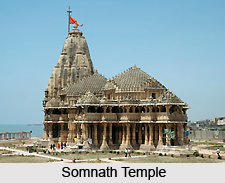 The places around Junagadh town are truly worthy to be placed in a prestigious, elevated position, as the crowning glory. When one thinks of fables or myths, Junagadh is the place to visit, to be enlightened in outlandish folklore. The legendary Somnath temple is just a few kilometres away from Junagadh, steeped in grandeur and lores.
The places around Junagadh town are truly worthy to be placed in a prestigious, elevated position, as the crowning glory. When one thinks of fables or myths, Junagadh is the place to visit, to be enlightened in outlandish folklore. The legendary Somnath temple is just a few kilometres away from Junagadh, steeped in grandeur and lores.
Gondal (64 km)
Halfway between Rajkot and Junagadh, Gondal was believed to be the only princely state in Saurashtra that did not levy tax on its subjects in the 19th century. During Bhagwat Singhji`s rule in Gondal (1884-1944), achievements were accomplished, like - laying of railway lines, inauguration of a school and penning down of a nine-volume history of Aryan Medical Science. It appears that the income generated by freight trains passing through the region used to raise considerable revenues for the state.
To have a fairer idea of the history of Gondal and its fascinating maharaja, it is best to start by visiting the Naulakha Palace. A look at the impressive Vintage Car Collection of the Gondal royal family is bound to etch in one`s memory.
To enter Naulakha Palace, one has to pay Rs. 50 for palace viewing and Rs. 100 to view the Vintage Car Collection. Visitings can be made from 9 a.m.- noon and again from 2.30 p.m. - 5.30 p.m. Camera can be taken without paying any remuneration.
Somnath (89 km)
The drive to Somnath, south of Junagadh, is as fascinating as the destination. It passes through Vanthali (16 km), where one can witness a number of 1940s Fords being run as taxis. Just short of Somnath is Veraval, a port with a history of maritime trade. Even today, it is a major ship-building centre for dhows. The wood comes from Malaysia.
Between Veraval and Somnath is the Bhalka Tirth, where Krishna is thought to have breathed his last. The site is lamentably modern and ostentatious. But if one drives past the wooded graveyards along the beach, one can envisage a forest of reeds here, planted by a curse - as the legend speaks. It is alleged that the reeds turned into maces, with which Krishna`s drunken Yadav clan gashed each other to death. Horror-stricken, Krishna ran into the forest, where he was killed by a hunter`s arrow.
Somnath has been a pilgrimage spot since a long period of time. It could be because of the Triveni Ghat, the convergence of three rivers - Hiran, Kapil and the mythical Saraswati. The Somnath Temple stands by the sea, its wall thrashed by waves. The first temple is believed to have been constructed by Somraj, the Moon God himself. The current temple was erected in 1961, after unearthing the ruins of the former temple at the site.



















